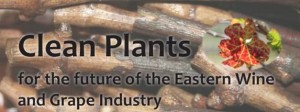I am forwarding this request to participate in a grape survey with USDA from Gary Keogh in the Concord, NH office. This survey is critically important to maintain an accurate count of the scope of the grape industry in New England. Results are used to apply for research and outreach funds, develop crop insurance opportunities, and advocate for the grape and wine industry. Participation is encouraged regardless of the scale/size of your operation.
Thanks,
Terry
From: Keough, Gary – NASS [mailto:Gary.Keough@nass.usda.gov]
Sent: Sunday, January 17, 2016 11:22 PM
Subject: New England Grape Survey, press release
The USDA National Agricultural Statistics Service, New England Field Office is about to conduct the 2015 New England Grape Production and Value Survey. Last year the survey results indicated the value of New England grown grapes sold in 2014 to be $4.2 million. We were able to publish some State estimates but limited response for some States didn’t allow us to do so. The results were published in the 2014 New England End of Season Fruit and Vegetable Yield and Price Report, http://www.nass.usda.gov/Statistics_by_State/New_England_includes/Publications/Special_Reports/eos2015v2.pdf
I’m asking for your help to encourage grape producers to respond. We will be mailing questionnaires in late January and phoning those that do not respond around mid-February. Below is a press release we will be sending out to press release email subscribers. If you are not already receiving our press releases or survey results you can do so at http://www.nass.usda.gov/Statistics_by_State/New_England/Subscribe_to_New_England_Reports/index.php.
Please contact me if you have any questions.

Gary R. Keough, State Statistician
U.S. Department of Agriculture | National Agricultural Statistics Service
Field Operations | New England Field Office
53 Pleasant St. Room 3450
Concord, NH 03301
T: 603-227-3129 | F: 603-225-1434 | M: 603-568-6535
Gary_Keough | www.nass.usda.gov
NEWS RELEASE
United States Department of Agriculture
NATIONAL AGRICULTURAL STATISTICS SERVICE
New England Field OFFICE
53 Pleasant St. Rm 3450, Concord, NH 03301
| FOR IMMEDIATE RELEASE |
Contact: Gary Keough |
| January 18, 2016 |
(603) 227-3129 |
USDA TO MEASURE NEW ENGLAND GRAPE PRODUCTION AND VALUE
Concord, New Hampshire – According to the 2012 Census of Agriculture, the number of New England grape growers and the acres planted to grapes continued to show substantial growth over the last few years. To learn more about the trends of New England grape production, the U.S. Department of Agriculture’s National Agricultural Statistics Service (NASS) is now conducting the 2015 New England Grape Production and Processing Survey.
“The New England Grape Industry has been asking for more data on the types of grapes grown and the value of production,” said Gary Keough, State Statistician of the NASS New England Field Office. “This is an opportunity for New England grape growers and processors to provide more detailed data to that shows the economic importance of their industry.”
NASS will mail the survey in late-January to all grape growers and processors in New England. The survey will look at the acreage, production, value of production, and utilization of the 2015 grape crop.
“The results of the survey will help show the importance of grape production in New England,” Keough noted. “In addition, the information can help producers make informed decisions about the future of their own farming operations.”
Recipients are requested to respond by mail by February 29, 2016. NASS will publish the results in April 2016. For more information about the New England Grape Production and Value Survey, call (603) 227-3129.
###
USDA is an equal opportunity provider and employer. To file a complaint of discrimination, write: USDA, Office of the Assistant Secretary for Civil Rights, Office of Adjudication, 1400 Independence Ave., SW, Washington, DC 20250-9410 or call (866) 632-9992 (Toll-free Customer Service), (800) 877-8339 (Local or Federal relay), (866) 377-8642 (Relay voice users).

Gary R. Keough, State Statistician
U.S. Department of Agriculture | National Agricultural Statistics Service
Field Operations | New England Field Office
53 Pleasant St. Room 3450
Concord, NH 03301
T: 603-227-3129 | F: 603-225-1434 | M: 603-568-6535
Gary_Keough | www.nass.usda.gov











